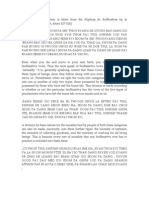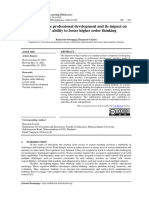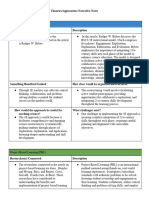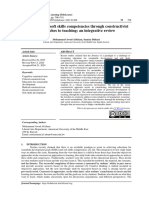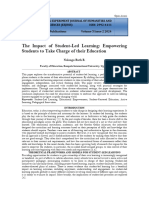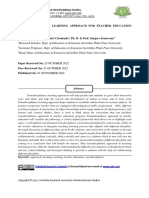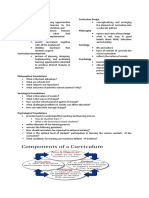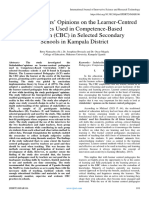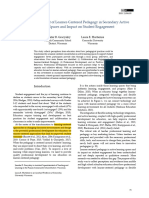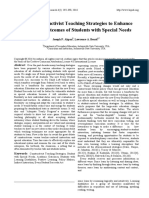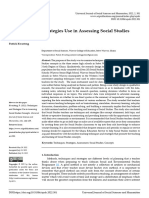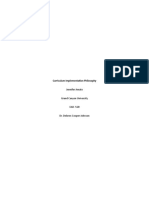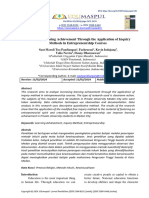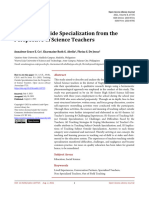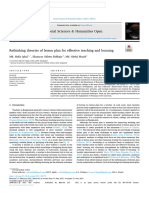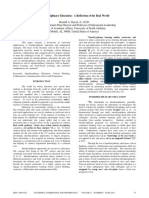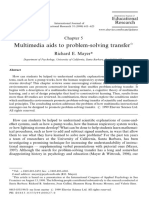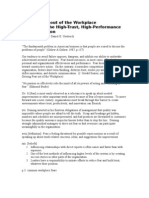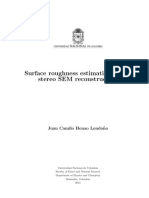Vishal Dagar
Vishal Dagar
Uploaded by
Baim LenloiCopyright:
Available Formats
Vishal Dagar
Vishal Dagar
Uploaded by
Baim LenloiOriginal Title
Copyright
Available Formats
Share this document
Did you find this document useful?
Is this content inappropriate?
Copyright:
Available Formats
Vishal Dagar
Vishal Dagar
Uploaded by
Baim LenloiCopyright:
Available Formats
See discussions, stats, and author profiles for this publication at: https://www.researchgate.
net/publication/308084623
Constructivism: A Paradigm for Teaching and Learning
Article · January 2016
DOI: 10.4172/2151-6200.1000200
CITATIONS READS
38 6,113
2 authors:
Vishal Dagar Aarti Yadav
delhi school of economics Central University of Haryana
13 PUBLICATIONS 39 CITATIONS 5 PUBLICATIONS 38 CITATIONS
SEE PROFILE SEE PROFILE
Some of the authors of this publication are also working on these related projects:
An Analysis of Variations in Technical Efficiency of Agricultural Production in Different Agro-Climatic Zones of Punjab and Haryana View project
Economic evaluation of watershed development (Sub Saharan Africa) View project
All content following this page was uploaded by Vishal Dagar on 10 November 2019.
The user has requested enhancement of the downloaded file.
ial Scienc
oc
S
es
Arts and
Journal
Arts and Social Sciences Journal Dagar and Yadav, Arts Social Sci J 2016, 7:4
DOI: 10.4172/2151-6200.1000200
ISSN: 2151-6200
Research Article Open Access
Constructivism: A Paradigm for Teaching and Learning
Dagar V * and Yadav A
Department of Education, Central University of Haryana, Mahendergarh District, Pali, India
*Corresponding author: Dagar V, Department of Education, Central University of Haryana, Mahendergarh District, Pali, India, Tel: 01285249401; E-mail:
dagarvishal99@gmail.com
Received date: June 08, 2016; Accepted date: July 01, 2016; Published date: July 07, 2016
Copyright: © 2016 Dagar V, et al. This is an open-access article distributed under the terms of the Creative Commons Attribution License, which permits unrestricted
use, distribution, and reproduction in any medium, provided the original author and source are credited.
Abstract
The present paper is a conceptual paper focusing on the need and ways of adopting constructivism in the
teaching and learning process. Our present education system emphasizes on preparing students for highly
competitive standardized tests and overlooks the importance of fostering critical thinking skills in our students. The
conventional teacher centric teaching learning process emphasizing on memorization is usually adopted across
length and breadth of Indian schools. This paper sketches the need to redefine education to include more critical
thinking by adopting constructivist pedagogy. The paper also proposes the important aspects such as integration of
social and emotional learning in learning process for adoption of constructivism in classrooms, besides this it also
outlines the learning strategies and learning design required for successful implementation of constructivism in
teaching learning process.
Keywords: Constructivism; Zone of proximal development; Social learning style and background knowledge fits well with the teaching
and emotional learning material. If the teaching style closely matches the students preferred
style of acquiring knowledge, learning becomes easier and more
Introduction natural, results improve and learning time is reduced. In few words,
traditional teaching material and strategies generally tend to benefit
Education involves the process of the development and learning of some students more than others [2].
the child on multiple dimensions, facilitated by the teacher, who is
guided by a curriculum. Effective education is a process where the The NCF, also suggests adopting critical pedagogy because students
teacher, children and the schools involved and participated actively [1]. are not just young people for whom adults should devise solutions.
However our present education system emphasizes on preparing They are critical observers of their own conditions and needs and
students for tests and don’t foster deep learning and is in the midst of a should be participants in discussion and problem-solving related to
crisis of quality-starting from primary schools to universities, the their education and future opportunities. Critical pedagogy provides
dominant view is that our students are not learning as much as they an opportunity to reflect critically on issues in terms of their political,
ideally should and what is more worrisome is that rote learning and social, economic and moral aspects.
memorization seems to be the dominant mode at all levels. Traditional The improvement in learning outcomes is possible by shifting the
teaching approach (lecture method) commonly adopted by teachers in focus of teaching learning process on concept development and deep
Indian schools involves coverage of the context and rote memorization understanding. Till now, most of the focus has been to ensure access to
on the part of the students and does not involve students in creative education. Therefore, a question arises on the philosophical
thinking and participation in the creative part of activities. Most of the underpinnings of the long dominant pretest-teach-post teach model of
time, during teaching learning process, instruction remains unilateral education. Despite completing all their tests, too many students simply
which is considered to be an orthodox activity. The upcoming trends in are not learning [3].
education changed the present scenario and adopted the constructivist
approach which is moral and more focused on innovative activities There arises a need to adopt a new pedagogy which encourages the
and knowledge acquisition and therefore, the academic results of the learner to construct a sense of her own self, the development of her
students of constructivist classrooms are better than traditional autonomy, alongside her progress within the group for interpersonal
classrooms. It was found that constructivist instructed students had growth. Pedagogy is a vehicle of articulating learning goals and
higher scores than the students who were exposed to conventional identifying the forms of activities that promote development toward
method of teaching. The problem lies in the learning environment in a those goals. Constructivist pedagogy is one such approach where
conventional classrooms, the classroom environment is teacher activities are proposed to students that are meaningful for them and
centered which makes learning process boring for less competent the learner reflects, searches, uses her capacity for taking initiatives and
students. Student’s attention wanes frequently and they are not able to for being creative. Constructivist pedagogy in which activity
retain the information for long time period and are often caught supplements lecture, learners are provided opportunities to construct
daydreaming, talking and pestering other students. The individual their own understanding on the basis of an interaction between what
differences existing between learners, their background knowledge and they already know.
learning styles are often ignored in the conventional classrooms. The need for constructivist approach arises when behaviorism fall
Present educational system provide a unique and standardized short of producing positive effects within the complex context of the
teaching material to all learners which tend to benefit to those whose classroom and left teachers feeling shortchanged and cheated by a
Arts Social Sci J Volume 7 • Issue 4 • 1000200
ISSN:2151-6200 ASSJ an open access journal
Citation: Dagar V, Yadav A (2016) Constructivism: A Paradigm for Teaching and Learning. Arts Social Sci J 7: 200. doi:
10.4172/2151-6200.1000200
Page 2 of 4
system that placed the guilt for students' failure to learn in their hands. "The doctrine itself holds that 'language users must individually
Following the legacy of behaviorism, constructivism has been construct the meaning of words, phrases, sentences and texts."
welcomed as a theory of knowing that more fully explains the
"Constructivists allege that it is we who constitute or construct, on
complexity of the teaching-learning process [4].
the basis of our theorizing or experience, the allegedly unobservable
items postulated in our theories."
Need of constructivism
"The central principles of this approach are that learners can only
The present article concentrates on providing an alternative make sense of new situations in terms of their existing understanding.
pedagogy based on the principles of constructivism theory given by Learning involves an active process in which learners construct
Piaget [5], Vygotsky [6] and other theoreticians including meaning by linking new ideas with their existing knowledge" [4].
psychologists and sociologists. If we accept constructivist theory, then
we have to give up platonic and all subsequent realistic views of
epistemology. We have to recognize that there is no such thing as
Social Constructivism
knowledge “out there”, independent of the knower but only knowledge The most important aspect on which constructivism focuses is
we construct for ourselves as we learn is the true knowledge. If we knowledge construction. Knowledge construction is viewed differently
believe that knowledge consists of learning about the real world “out by different philosophers and psychologists. Jean Piaget’s view is
there”, then the power of organizing and presenting the knowledge is constructivist, because he firmly believed that knowledge acquisition is
passed on to the teacher who ultimately passes this on to the learner. In a process of continuous self-construction. Children acquire knowledge
the process of disseminating knowledge to learners the teacher may through their actions and passes through stages of assimilation,
use activities and opportunities to experiment but here the teacher is accommodation and equilibrium in the process of knowledge
helping the learner to understand the world but don’t ask the learner to construction. The father of social constructivism, Vygotsky [6] views
construct his/her own world. the origin of knowledge construction as being the social intersection of
The understanding of the difference between the world “out there” people, interactions that involve sharing, comparing and debating
and the students own world helps a teacher to decide the type of among learners and mentors. Through a highly interactive process, the
pedagogy he will follow to create a constructivist classroom. When the social milieu of learning is accorded center stage and learners both
teacher structures situations for his/her students then she is restricting refine their own meanings and help others find meaning. In this way
the learners to carry out their own mental actions. These two worlds, knowledge is mutually built. This view is a direct reflection of
the world “out there” and “own world” puts the teacher in a dilemma of Vygotsky’s [6] sociocultural theory of learning, which accentuates the
presenting the knowledge or to help students to construct their own supportive guidance of mentors as they enable the apprentice learner
knowledge. Teacher opting for the second option intensifies her to achieve successively more complex skill, understanding, and
problem because the curriculum designed by the experts, classrooms ultimately independent competence [9]. Vygotsky [6] asserted that
environment created and followed in a school, instructional design knowledge can’t be isolated from social and cultural context. He argues
adopted by a teacher and learning habits of the students’ needs a major that all higher mental functions are social in origin and are embedded
redesigning by the teacher. The theories of learning, strategies of in the context of sociocultural setting. In social constructivist model,
teaching and learning and the pedagogies are the guiding principles in the knowledge is constructed through interaction between teacher and
framing an instructional design. The instructional design following student. The role of teacher in social constructivist approach shifts
constructivist ideology avoids directing a pupil towards a solution to from the sole dispenser of knowledge to motivator, guide and resource
the problem rather it encourages self-conceptualization of the solution. person. Constructivism emphasizes on learner centered, learner
There is a need to develop a learning design using constructivist directed and collaborative style of teaching learning process in which
learning strategies which follows the principles of social constructivism learning is supported by teacher scaffolding and authentic tasks.
and also aims at developing social and emotional skills in students by
using social constructivism in classrooms. Elias et al. [7] defined SEL Constructivist Learning Strategies
as the process of acquiring core competencies to recognize and manage
The constructivist learning strategies can be developed using
emotions, set and achieve positive goals, appreciate the perspectives of
principles of social constructivism to improve academic achievement,
others, establish and maintain positive relationships, make responsible
high order thinking skills and social and emotional skills of the
decisions, and handle interpersonal situations constructively. The
students. The constructivist environment in a classroom can be created
proximal goals of SEL programs are to foster the development of five
by adopting the following:
interrelated sets of cognitive, affective, and behavioral competencies:
self-awareness, self-management, social awareness, relationship skills, Provide experience with the knowledge construction process
and responsible decision making [8].
The teacher presents a topic to the learners and guides them to
explore the topic through experimentation. The learners are
Definitions for constructivism in education are as follows encouraged to frame a research question and teacher helps them to
"It is assumed that learners have to construct their own knowledge answer the research question framed by them through scaffolding.
individually and collectively. Each learner has a tool kit of concepts and Experience in and appreciation for multiple perspectives
skills with which he or she must construct knowledge to solve
problems presented by the environment. The role of the community, All learners are distinct from each other in their way of thinking
other learners and teacher is to provide the setting, pose the challenges, and so the need arises to look at a problem from multiple perspectives
and offer the support that will encourage mathematical construction." and provide the opportunities to learners to experiment and discuss
their alternative ways of thinking. Here, the students are encouraged to
Arts Social Sci J Volume 7 • Issue 4 • 1000200
ISSN:2151-6200 ASSJ an open access journal
Citation: Dagar V, Yadav A (2016) Constructivism: A Paradigm for Teaching and Learning. Arts Social Sci J 7: 200. doi:
10.4172/2151-6200.1000200
Page 3 of 4
work in groups. Finally, all the groups can share their opinions on the to content knowledge development. Scaffolding comes to the rescue of
topic with each other. teachers who want to design activities to link future actions with the
present and help learners in development of content knowledge by
Provide social and emotional learning
themselves [10]. Vygotsky [6] also talks about zone of proximal
The social and emotional aspects of learning will be taught to the development. He developed concept of zone as an alternative to static,
students in an integrated manner. The five aspects of social and individual testing, namely IQ testing. He asserted on assessment of
emotional learning which could be covered in the teaching are as mental functions through collaborative activities and not independent
follows: self-awareness, managing feelings, motivation, empathy and and isolated activities.
social skills.
Constructivism, an epistemological view of knowledge acquisition
Use multiple modes of representation emphasizes on four aspects: 1) knowledge construction rather than
knowledge transmission and the recording of information conveyed by
The multiple modes of representation also assist the goal of
others, 2) new learning builds on prior knowledge, 3) learning is
experiencing multiple perspectives. Use of multiple media to enrich the
enhanced by social interaction and 4) meaningful learning develops
learning environment provides the learners to view the topic being
through authentic tasks. The role of the learner is conceived as one of
discussed in the class from multiple dimensions.
building and transforming knowledge [9]. Effective constructivist
The teacher should prepare a list of media available and supporting pedagogy should be based on the following seven principles as these
the topic. The teacher should also decide the use of media in appear to be most common across studies. First, the emphasis is not on
supporting the authentic nature of the task. memorizing and reproducing knowledge, but not on using and
transforming it. Second, acquiring and using knowledge are not
A combination of the following learning strategies can be used by
separate phases; rather, knowledge is learned by using it. Third,
the teachers to create constructivist learning environment
knowledge is used especially to solve problems. Fourth, stimulating
• Use of multimedia/teaching aids students thinking activities and enhancing their metacognitive and
• Scaffolding self-regulative skills are embedded in the study of content knowledge.
• Case studies Fifth, social interaction has a central role in the learning process. Sixth,
• Role playing assessment of learning is embedded in the learning process. Seventh,
students themselves must be involved in the assessment of their
• Story telling
learning. The learning outcomes of a constructivist classroom are
• Group discussions/Group activities (reciprocal Learning). divided into subject-based, personal transferable, and generic
• Probing questions academic outcomes. The learning outcomes measured by traditional
• Project based learning examination questions belong to the first category i.e., subject-based
• Use of learning strategies for social and emotional learning of outcomes. These are the learning outcomes usually assessed in
students. university courses. However, the personal transferable outcomes, such
as independent work, cooperation and communication skills, and
The teacher can follow the under mentioned learning design while using information, as well as the generic academic outcomes, such as
conducting group work or in general thinking critically and synthesizing ideas and information, are learning
Situation: A situation will be presented to the students to work outcomes that are supposed to be produced along with the subject-
upon. based outcomes. However, traditional instruction does not pay much
attention to the latter two. It was reported that the students in the
Bridge: The teacher tries to know the existing knowledge level of the constructivist group described their learning in terms of the personal
students and tries to find out the gap in the existing level and the level transferable skills and the generic academic outcomes, while the
where they should reach at the end of discussion. This is carried out students in the control group (traditional classroom) talked mainly
with the help of suitable questions and activities. about the subject-based learning outcomes. The subject-based
Grouping: The students are then divided into groups to explore the outcomes were roughly equal in both groups, but the transferable and
problem presented in their own perspective. Here the students of generic academic outcomes were reported more often by the
varying perspectives will be included in a group. constructivist group students. However, applying constructivist
principles in teaching is not an easy task; it requires strong knowledge
Questions: The teacher may adopt the strategy of probing questions base in the subject matter domain and teachers need knowledge about
to assist them move towards their goal. the processes of learning.
Exhibit: The students are expected to exhibit or explain their
understandings regarding the topic to other students. Constructivist Classroom
Reflections: Students present their reflections on the entire process Palinscar [11,12] quoted the arguments of Damon [13] who
of building understanding of the topic. suggested that development of learning requires giving up of current
understanding of a concept to reach a new perspective and this might
Constructivism: Zone of Proximal Development, be attained through interaction with peers. On the other hand,
Principles and Learning Outcomes learning that doesn’t require a transformation of perspective but is
characterized as acquiring a new skill might be best attained by
Teachers usually focus on basic literacy routines (reading fluency, working with skillful partners such as adults. The guidance provided by
note taking structures), skills and test preparation due to the use of the adult is called scaffolding which is required to help a learner to pass
standardized testing to measure learning outcomes. This may the zone of proximal development. Zone of proximal development is
encourage providing high support to learners and minimize attention
Arts Social Sci J Volume 7 • Issue 4 • 1000200
ISSN:2151-6200 ASSJ an open access journal
Citation: Dagar V, Yadav A (2016) Constructivism: A Paradigm for Teaching and Learning. Arts Social Sci J 7: 200. doi:
10.4172/2151-6200.1000200
Page 4 of 4
the distance between the actual developmental level as determined by theoretical, practical and self-regulative knowledge. However, in a
independent problem solving and the level of potential development as traditional type of curriculum these different types of knowledge have
determined through problem solving under adult guidance or in been treated separately. One of the most important challenges to
collaboration with more capable peers. The common conception of the pedagogy is developing curricula and teaching methods so that true
zone of proximal development presupposes an interaction between a integration of formal, theoretical knowledge and more informal,
more competent person and a less competent person on a task, such practical, and self-regulative knowledge may be achieved. The aspect of
that the less competent person becomes independently proficient at assessment cannot be left untouched while talking of constructivism as
what was initially a jointly accomplished task. The common conception constructivist learning requires an entirely different approach to
of the zone of proximal development supports or inspires a vision of assessment, an approach that is qualitative in nature. Authentic
educational perfection, in which the insightful (or lucky) teacher is assessment based on real-life tasks and performance assessment
able to help a child master, effortlessly and joyfully [14]. requiring students to complete certain learning assignments represent
this type of assessment. The emphasis is on students' learning process
A constructivist classroom is identified by the percentage of the
and on their meaning making as much as (or even more than) on the
time spent on student centered activities and it should be dominated
final product.
by collaborative learning style. The activity structures studied by
Forman et al. indicated that 70% of the class time was spent on student
centered activities (155 devoted to study presentations and 55% References
devoted to pair and small group work) and the rest 30% time was 1. Behar A (2014) Teacher education, not training.
teacher centered, where the teacher’s interactions were facilitative
2. Franzoni AL, Assar S (2009) Student learning styles adaptation method
rather than directive. On the other side, in a traditional classroom only based on teaching strategies and electronic media. Educational
1% time is devoted to small group work and the rest of the time is Technology & Society 12: 15-29.
devoted to independent seat work and teacher directed recitation 3. Brooks JG, Brooks MG (1999) In Search of Understanding: The Case for
[15,16]. Constructivist Classroom. Association for Supervision and Curriculum
Development. Virginia, USA.
The learning strategies suggested by Taylor and Cox to be included
in socially assisted learning environment are: a) use of a reflection 4. Jones MJ, Araje LB (2002) The impact of constructivism on education-
Language, Discourse, and Meaning. American Communication Journal 5:
board in which members could share publicly their representation of 1-10.
the problem; b) Peer collaboration; c) reflective questioning; d) 5. Piaget J (1967) Biologist connaissance (Biology and knowledge).
scaffolding; e) shared ownership; f) quizzes, feedback and rewards; g) Gallimard, Paris.
daily lessons in the regular classrooms. The learning strategy that 6. Vygotsky LS (1978) Tool and symbol in child development. In: Cole M,
facilitates active construction of knowledge includes use of John-Steiner V, Scribner S, Souberman E (eds.) Mind in Society-the
multimedia, Socratic dialogues, scaffolding, and role playing games, development of higher psychological processes. Harvard University Press,
simulations, storytelling and case studies. Cambridge.
7. Elias MJ, Zins JE, Weissberg RP, Frey KS, Greenberg MT, et al. (1997)
Further, the pedagogical goals determined to construct a Promoting social and emotional learning-Guidelines for educators.
constructivist learning environment are as follows: Association for Supervision and Curriculum Development, Alexandria.
• Provide learning experience with the knowledge construction 8. Collaborative for Academic, Social, and Emotional Learning (2005) Safe
and sound: An educational leader’s guide to evidence-based social and
process.
emotional learning programs-Illinois edition, Chicago.
• Provide learning experience in and appreciation for multiple
9. James M, Applefield R, Mahnaz M (2001) Constructivism in theory and
perspectives. practice-toward a better understanding. The High School Journal 84:
• Embed learning in realistic and relevant contexts. 35-53.
• Encourage ownership and voice in the learning process. 10. Athanases SZ, Oliveira LCD (2014) Scaffolding versus routine support for
• Embed learning in social experience. latina/o youth in an urban school: tensions in building toward
disciplinary literacy. Journal of Literacy Research 46: 263–299.
• Encourage the use of multiple modes of representation.
11. Palincsar AS (1998) Keeping the metaphor of scaffolding fresh-a response
• Encourage self-awareness of the knowledge construction process. to c. addison stone's “The metaphor of scaffolding: its utility for the field
of learning disabilities”. Journal of Learning Disabilities 31: 370-373.
Conclusion 12. Palinscar AS (1998) Social constructivist perspective in teaching and
learning. Annual Rev Psychology 49: 345-375.
The focus of education needs to be shifted from placing content in 13. Damon W (1984) Peer education-the untapped potential. Journal of
students’ knowledge building. If the focus of studying could be turned applied Behavior Psychology 5: 331-343.
from filling one’s mind to producing knowledge products, students 14. Chaiklin S (2003) The zone of proximal development in vygotsky’s
wouldn’t need to concentrate on memorization and cramming for analysis of learning and instruction. In: Kozulin A, Gindis B, Ageyev VS,
examinations. These knowledge products could be in form of essays, Miller SM (eds.) Vygotsky’s educational theory in cultural context.
term papers, project reports, research papers, videos, posters, slides, Cambridge University Press, New York.
portfolios, or whatever products that students might create. In 15. http://planningcommission.gov.in/hackathon/Education.pdf
classroom instruction there is a need of integration of formal, 16. Johnson PA (2014) Constructivism-A Short Story.
Arts Social Sci J Volume 7 • Issue 4 • 1000200
ISSN:2151-6200 ASSJ an open access journal
View publication stats
You might also like
- A Jewel From My Mother's CrownDocument289 pagesA Jewel From My Mother's CrownGiri Ratna Singh100% (12)
- Highway For BodhisattvasDocument40 pagesHighway For BodhisattvasJamyang ThinleyNo ratings yet
- Monitoring & Evaluation Framework - FiinovationDocument19 pagesMonitoring & Evaluation Framework - FiinovationInnovative Financial Advisors Pvt.ltd100% (3)
- 3.0 Identifying Learning Progression and Learning TargetsDocument8 pages3.0 Identifying Learning Progression and Learning TargetsNelia Grafe75% (4)
- Constructivism A Paradigm For Teaching and Learning 2151 6200 1000200Document5 pagesConstructivism A Paradigm For Teaching and Learning 2151 6200 1000200Andrea LovatoNo ratings yet
- Constructivism A Paradigm For Teaching and Learning 2151 6200 1000200Document4 pagesConstructivism A Paradigm For Teaching and Learning 2151 6200 1000200Nurl AinaNo ratings yet
- A Collaborative Professional Development and Its Impact On Teachers' Ability To Foster Higher Order ThinkingDocument9 pagesA Collaborative Professional Development and Its Impact On Teachers' Ability To Foster Higher Order ThinkingJournal of Education and LearningNo ratings yet
- Constructivism A Paradigm For Teaching and LearningDocument4 pagesConstructivism A Paradigm For Teaching and LearningShofiah Nur AzizahNo ratings yet
- Basic Requirements of TeachingDocument2 pagesBasic Requirements of TeachingEditor IJTSRDNo ratings yet
- Ensuring Student Critique Paper Method of TeachingDocument3 pagesEnsuring Student Critique Paper Method of TeachingJf CatubayNo ratings yet
- 2018 Cohenmiler Et Al Effective Teaching StrategiesDocument16 pages2018 Cohenmiler Et Al Effective Teaching StrategiesAnnas Rulloh ZulficarNo ratings yet
- The Benefits of Using Collaborative Learning Strategy in Higher EducationDocument8 pagesThe Benefits of Using Collaborative Learning Strategy in Higher EducationIJELS Research JournalNo ratings yet
- Revised PED 702 - MA ELEDocument31 pagesRevised PED 702 - MA ELEMarvic ReyesNo ratings yet
- Ped 702 Topic 1Document15 pagesPed 702 Topic 1amara de guzmanNo ratings yet
- Theories Narrative 1Document6 pagesTheories Narrative 1api-744058173No ratings yet
- Rethinking Theories of Lesson Plan For Effective Teaching and LearningDocument8 pagesRethinking Theories of Lesson Plan For Effective Teaching and LearningYvette SalvadorNo ratings yet
- ESD Goals and Soft Skills Competencies Through Constructivist Approaches To Teaching: An Integrative ReviewDocument11 pagesESD Goals and Soft Skills Competencies Through Constructivist Approaches To Teaching: An Integrative ReviewJournal of Education and LearningNo ratings yet
- The Impact of Student-Led Learning: Empowering Students To Take Charge of Their EducationDocument4 pagesThe Impact of Student-Led Learning: Empowering Students To Take Charge of Their Educationpublication1No ratings yet
- The Impact of The Constructivist Teaching Model in Enhancing Reading SkillsDocument17 pagesThe Impact of The Constructivist Teaching Model in Enhancing Reading SkillsGlobal Research and Development Services100% (1)
- Transdisciplinary Learning Approach For Teacher Education ProgramDocument8 pagesTransdisciplinary Learning Approach For Teacher Education ProgramAnonymous CwJeBCAXpNo ratings yet
- Pedagogy WorkshopDocument24 pagesPedagogy WorkshopmetahelpcentermanagementNo ratings yet
- Constructivist Learning Paradigm As The Basis On Learning Model DevelopmentDocument6 pagesConstructivist Learning Paradigm As The Basis On Learning Model DevelopmentAyu Kusuma DewiNo ratings yet
- Ijmcer KK0630730783Document54 pagesIjmcer KK0630730783Laarni QuimpanNo ratings yet
- Interactive Teaching StrategiesDocument3 pagesInteractive Teaching Strategieszckid5136100% (1)
- Integrative Methods in Teaching Social ScienceDocument5 pagesIntegrative Methods in Teaching Social ScienceJasher JoseNo ratings yet
- Definition of Terms Curriculum Curriculum DesignDocument11 pagesDefinition of Terms Curriculum Curriculum DesignBernard Vincent Guitan MineroNo ratings yet
- THEORIES OF LANGUAGE TEACHING - Anagaran, Jef-JefDocument6 pagesTHEORIES OF LANGUAGE TEACHING - Anagaran, Jef-JefJefJef AnagaranNo ratings yet
- The Stakeholders' Opinions On The Learner-Centred Pedagogies Used in Competence-Based Curriculum (CBC) in Selected Secondary Schools in Kampala DistrictDocument15 pagesThe Stakeholders' Opinions On The Learner-Centred Pedagogies Used in Competence-Based Curriculum (CBC) in Selected Secondary Schools in Kampala DistrictInternational Journal of Innovative Science and Research TechnologyNo ratings yet
- Factors Contributing To Persistence of Teacher Centered Learning in The Higher Educational Sector of Sri LankaDocument6 pagesFactors Contributing To Persistence of Teacher Centered Learning in The Higher Educational Sector of Sri LankaEditor IJTSRDNo ratings yet
- Andragogy: A Theory in Practice in Higher EducationDocument17 pagesAndragogy: A Theory in Practice in Higher EducationAliya NurainiNo ratings yet
- 5804-Article Text-11317-1-10-20210121Document15 pages5804-Article Text-11317-1-10-20210121Karolina DudekNo ratings yet
- CJR B InggrisDocument8 pagesCJR B InggrisNisa Fitriyana hasibuanNo ratings yet
- Progressive Pedagogies and Teacher Education - A Review of The LiteratureDocument20 pagesProgressive Pedagogies and Teacher Education - A Review of The LiteraturechristopherlawsonNo ratings yet
- Strategies Trends Methodsand Techniquesof Teachinginthe NewDocument11 pagesStrategies Trends Methodsand Techniquesof Teachinginthe NewJmNo ratings yet
- Cooperative Learning Approach in An Outcomes Based EnvironmentDocument10 pagesCooperative Learning Approach in An Outcomes Based EnvironmentkomNo ratings yet
- Learner-Centered MethodDocument17 pagesLearner-Centered MethodNURUL ATIQAH ZAHITNo ratings yet
- Ej 1089692Document8 pagesEj 1089692Kevin RoseNo ratings yet
- Creative Thinking and Student Centred Learning in UG Classroom: A Small SurveyDocument6 pagesCreative Thinking and Student Centred Learning in UG Classroom: A Small SurveyAna BeNo ratings yet
- Activity No. 7 and 8 Policy AnalysisDocument6 pagesActivity No. 7 and 8 Policy AnalysisMa Abegail Calayag CaranganNo ratings yet
- Tech-and-Strat-Use-in-Soc-studiesDocument16 pagesTech-and-Strat-Use-in-Soc-studiesJoven Mar BrigoleNo ratings yet
- Curriculum Implementation PhilosophyDocument5 pagesCurriculum Implementation Philosophyapi-652822049No ratings yet
- Jurnal Increasing Learning Achievement Through The Application of Inquiry Methods in Entrepreneurship CoursesDocument6 pagesJurnal Increasing Learning Achievement Through The Application of Inquiry Methods in Entrepreneurship CoursesStudent GardeniaNo ratings yet
- AssignmentDocument23 pagesAssignmentIqra FatimaNo ratings yet
- Pengembangan Lembar Kerja Siswa Berorientasi Higher Order Thinking Skills Pada Materi Impuls Dan MomentumDocument10 pagesPengembangan Lembar Kerja Siswa Berorientasi Higher Order Thinking Skills Pada Materi Impuls Dan Momentumrozatun munawarahNo ratings yet
- Approaches To Curriculum DesignDocument16 pagesApproaches To Curriculum DesignKlaimark Ramento CadelinaNo ratings yet
- Parison Between Activity-Based Learning and Traditional LearningDocument12 pagesParison Between Activity-Based Learning and Traditional LearningMoataz BelkhairNo ratings yet
- DidacticmethodologyDocument18 pagesDidacticmethodologyJoven Mar BrigoleNo ratings yet
- A Comparative Study of Subject-centred Approach and Broad-fields Approach to Teaching and Their Implementation at Primary Level in IndiaDocument8 pagesA Comparative Study of Subject-centred Approach and Broad-fields Approach to Teaching and Their Implementation at Primary Level in IndiaINDIAN JOURNAL OF MULTIDISCIPLINARY RESEARCH (IJOMR)No ratings yet
- Untitled DocumentDocument16 pagesUntitled DocumentVishakha Sankhala100% (1)
- Using Social Science Research To Form Pedagogical Practices: Evidence-Based Teaching StrategiesDocument9 pagesUsing Social Science Research To Form Pedagogical Practices: Evidence-Based Teaching StrategiesIJAR JOURNALNo ratings yet
- Innovative TeachingDocument7 pagesInnovative Teachingkevin_aloeNo ratings yet
- Teaching Outside Specialization From The PerspectiDocument13 pagesTeaching Outside Specialization From The Perspectikrstneayoprdrgz1999No ratings yet
- FCR Paper PH.D 1Document13 pagesFCR Paper PH.D 1maanu86No ratings yet
- Iqbal et al., 2021Document10 pagesIqbal et al., 2021Irda AmaliaNo ratings yet
- A Comparative Study of Traditional and Smart Classrooms in Relation To Their Creativity and Academic AchievementDocument6 pagesA Comparative Study of Traditional and Smart Classrooms in Relation To Their Creativity and Academic Achievementkarima.kadariNo ratings yet
- Seminar On Disciplinary Knowledge and Pedagogical Approaches in School SubjectsDocument11 pagesSeminar On Disciplinary Knowledge and Pedagogical Approaches in School SubjectsPanchami R. SNo ratings yet
- Module 5 Adults Teaching Learning PrinciplesDocument13 pagesModule 5 Adults Teaching Learning PrinciplesmainedaamoNo ratings yet
- Quality in Classroom TransactionDocument3 pagesQuality in Classroom TransactionrajmohapatraNo ratings yet
- EDUC 5220-01 1 Pa AssignmentDocument6 pagesEDUC 5220-01 1 Pa AssignmentSana Younus Horani - 71346/TCHR/BNMNo ratings yet
- A Review of The Effects of Active Learning On High Order Thinking Skills: A Meta-Analysis Within Islamic EducationDocument10 pagesA Review of The Effects of Active Learning On High Order Thinking Skills: A Meta-Analysis Within Islamic EducationJournal of Education and LearningNo ratings yet
- Interdisciplinary Education: A Reflection of The Real WorldDocument6 pagesInterdisciplinary Education: A Reflection of The Real WorldaNo ratings yet
- The Potential of The Discovery Learning Model Integrated The Reading, Questioning, and Answering Model On Cross-Cultural High School Students' Problem-Solving SkillsDocument9 pagesThe Potential of The Discovery Learning Model Integrated The Reading, Questioning, and Answering Model On Cross-Cultural High School Students' Problem-Solving SkillsJournal of Education and LearningNo ratings yet
- Development of Collaborative Learning-Based Science Learning Tools To Train Critical Thinking Skills and Understanding The Concepts of Grade V Elementary Students PDFDocument9 pagesDevelopment of Collaborative Learning-Based Science Learning Tools To Train Critical Thinking Skills and Understanding The Concepts of Grade V Elementary Students PDFInternational Journal of Innovative Science and Research TechnologyNo ratings yet
- Effective Learning: Exploring Innovative Teaching Methodologies: Innovative Education: Strategies, Challenges, and Solutions in PedagogyFrom EverandEffective Learning: Exploring Innovative Teaching Methodologies: Innovative Education: Strategies, Challenges, and Solutions in PedagogyNo ratings yet
- Borang Ambilan Suhu Tahap 1Document14 pagesBorang Ambilan Suhu Tahap 1Baim LenloiNo ratings yet
- Philosophy Science Education and Culture PDFDocument129 pagesPhilosophy Science Education and Culture PDFBaim LenloiNo ratings yet
- National Art Education AssociationDocument5 pagesNational Art Education AssociationBaim LenloiNo ratings yet
- (1961 Saunders) Contribution of Victor Lowenfeld To Art EducationDocument8 pages(1961 Saunders) Contribution of Victor Lowenfeld To Art EducationBaim LenloiNo ratings yet
- (1999 Mayer) Multimedia Aids To Problem-Solving TransferDocument13 pages(1999 Mayer) Multimedia Aids To Problem-Solving TransferBaim LenloiNo ratings yet
- (2001 Mcleod) Introduction Critical Issues in The Methodology ofDocument6 pages(2001 Mcleod) Introduction Critical Issues in The Methodology ofBaim LenloiNo ratings yet
- Phenomenological Methodology in The Human Sciences: AbstractDocument7 pagesPhenomenological Methodology in The Human Sciences: AbstractBaim LenloiNo ratings yet
- Saradi The Kallos of The Byzantine CityDocument21 pagesSaradi The Kallos of The Byzantine Citykostaspanzer1No ratings yet
- The Success Formula - Bob BurgDocument34 pagesThe Success Formula - Bob BurgPhilip J. Loftus100% (5)
- If It Can't Be Expressed in Figures... Project Performance ManagementDocument7 pagesIf It Can't Be Expressed in Figures... Project Performance ManagementDiana BarbuNo ratings yet
- Draupadi's BirthDocument6 pagesDraupadi's BirthGoda KannaiahNo ratings yet
- Imc Plan OverviewDocument16 pagesImc Plan OverviewtajalaNo ratings yet
- Ibnu Arabi On Wahdatul Wujud and It's Relation To The Concept of Af'âl Al-'IbâdDocument22 pagesIbnu Arabi On Wahdatul Wujud and It's Relation To The Concept of Af'âl Al-'IbâdAfif MuchromNo ratings yet
- PD ActivityDocument5 pagesPD ActivityNathalie SerafinNo ratings yet
- Project Management - MGMT627 2011 Solved McqsDocument11 pagesProject Management - MGMT627 2011 Solved McqsAngel RockNo ratings yet
- Number TheoryDocument53 pagesNumber TheorymoiibdNo ratings yet
- Book of FitnessDocument8 pagesBook of FitnessAnonymous 2a0rZk7No ratings yet
- Laguilles - He Pantawid Pamilyang Pilipino Program (4Ps)Document12 pagesLaguilles - He Pantawid Pamilyang Pilipino Program (4Ps)Meera Joy Deboma Blanco0% (1)
- Principles of Wiccan Beliefs - Princípios WICCADocument2 pagesPrinciples of Wiccan Beliefs - Princípios WICCAvilmar konageski jrNo ratings yet
- MGB Solution Chapter 1 Q4Document1 pageMGB Solution Chapter 1 Q4Seow Fan ChongNo ratings yet
- Driving Fear Out of The WorkplaceDocument5 pagesDriving Fear Out of The WorkplacedewdropmasNo ratings yet
- Try Giving Yourself AwayDocument131 pagesTry Giving Yourself AwayChess Games100% (1)
- Week 1 DLP, Formative, SummativeDocument15 pagesWeek 1 DLP, Formative, SummativeuniversaljulyNo ratings yet
- AnalogiesDocument4 pagesAnalogiesBerna Baoya0% (1)
- Superposition Theorem - GATE Study Material in PDFDocument8 pagesSuperposition Theorem - GATE Study Material in PDFSupriya SantreNo ratings yet
- Caribbean Sociology 3Ch 2 Conflict MarxistDocument5 pagesCaribbean Sociology 3Ch 2 Conflict MarxistDA10000100% (1)
- Surface Roughness Estimation by 3D Stereo SEM ReconstructionDocument70 pagesSurface Roughness Estimation by 3D Stereo SEM ReconstructionARIF PUJI LAKSONONo ratings yet
- Abstract Data Type ADBMSDocument6 pagesAbstract Data Type ADBMSDeepak Kumar RajakNo ratings yet
- What Is Consumer Buying Behavior? Definition ofDocument7 pagesWhat Is Consumer Buying Behavior? Definition ofBipin RawatNo ratings yet
- The Bagua Manual of SunlutangDocument70 pagesThe Bagua Manual of SunlutangBull ChapterNo ratings yet
- Research Proposal FractalsDocument4 pagesResearch Proposal FractalsDenise FernandoNo ratings yet
- KJV Word Study BibleDocument32 pagesKJV Word Study BibleThomas Nelson Bibles100% (11)
- Leadership: Styles & PhrasesDocument4 pagesLeadership: Styles & Phrasesapi-423310252No ratings yet

